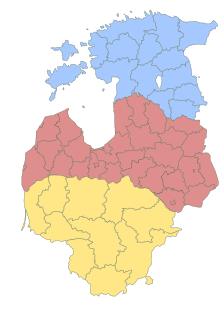Singing revolution
The period of national movements in the Baltic States from 1987 to 1991 and of the non-violent struggle to regain national independence is referred to as the Singing Revolution .
Meaning of the songs
In the Soviet Union it was strictly forbidden to sing songs in which the patriotism another fatherland was considered the official, supposedly "single" transnational country, that of the Soviet Union. These "frowned upon" (literally: punishable) patriotic songs included the hymns of the Baltic states, which had been forcibly incorporated by the USSR since the Second World War: those who dared to sing them were threatened with severe sanctions ranging from losing their job to being deported to Siberia .
Period of perestroika
During perestroika (1988–1991) people sang at national assemblies and peaceful demonstrations (in Vingio parkas and Kalnų parkas in Lithuania , in Mežaparks in Latvia , in Hirvepark in Estonia, etc.). Hundreds of thousands of people gathered in public squares and stadiums to announce their aspirations and express their views on the Soviet occupation and annexation . In particular, traditional folk songs, Dainas , were sung , which unified the people ideally and emotionally and thus testified to the common cultural experience and past.
In order for the independence of the Baltic States to demonstrate, formed on 23 August 1989, exactly 50 years after the Hitler-Stalin pact around two million people, the Baltic Way , a human chain over a length of 600 kilometers from Tallinn via Riga to Vilnius .
Even today, folk songs are sung in the Baltic states on national memorial days in a traditional or 'modern' version (e.g. with well-known rock bands) on the stages of the big cities. They are also distributed as CDs and DVDs.
In Estonia
Since the Finnish radio YLE , whose radio and television programs could be received in the north, played the Finnish national anthem at the end of the day , the Estonian anthem also remained in the public consciousness, as the melody is the same.
During the "Singing Revolution" in Estonia , the song was intoned again many times. At a demonstration on the Lauluväljak (Singers' Festival) in 1988, 300,000 Estonians sang their forbidden anthem again for the first time.
When the country gained independence, it became the official national anthem again.
In Latvia
After the population demonstrated against Article 6 of the Latvian Constitution , which established the right to leadership of the Communist Party of Latvia , the Supreme Soviet changed the article on December 29, 1989: the right to leadership was deleted; from now on every social organization could participate in the formation of political will within the framework of the law.
Bloody arguments and enforcement of independence
In the spring of 1990, the Baltic states proclaimed the restoration of their independence (Lithuania: March 11th, Latvia: May 4th, Estonia: May 8th). In January 1991, there were bloody clashes in Lithuania and Latvia between civilians and Lithuanian and Latvian forces on the one hand and Soviet units on the other. On the so-called Vilnius Blood Sunday , January 13, 1991, a total of 14 unarmed civilians were killed when the television tower in Vilnius was attacked .
In the independence referendum on February 9, 1991, with a participation of 85% of the electorate, 90.5% voted for an independent Lithuania. As a result, Iceland became the first country in the world to recognize Lithuania's independence through a parliamentary resolution. In the following years, members of the Soviet special unit OMON killed seven Lithuanian border guards in an attack on a border post.
In Riga , the storm on the Ministry of the Interior (Raiņa bulvāris and Komunāru [today Reimersa] iela) on January 20, 1991 claimed five deaths from Soviet military forces.
Only on September 6, 1991, after the failed August coup in Moscow against Mikhail Gorbachev , did the Soviet Union recognize the independence of the three Baltic states.
literature
- Guntis Šmidchens: The power of song. Nonviolent national culture in the Baltic singing revolution . University of Washington Press, Seattle 2014, ISBN 978-0-295-99310-2 .
Web links
- Film about the Singing Revolution on YouTube
- Barricades for freedom. Moskauer Deutsche Zeitung , January 20, 2006, accessed on December 18, 2015 (article on the barricades in Riga).
Individual evidence
- ↑ a b December 29, 1989. Tagesschau (ARD) , December 29, 1989, accessed on December 29, 2016 .


